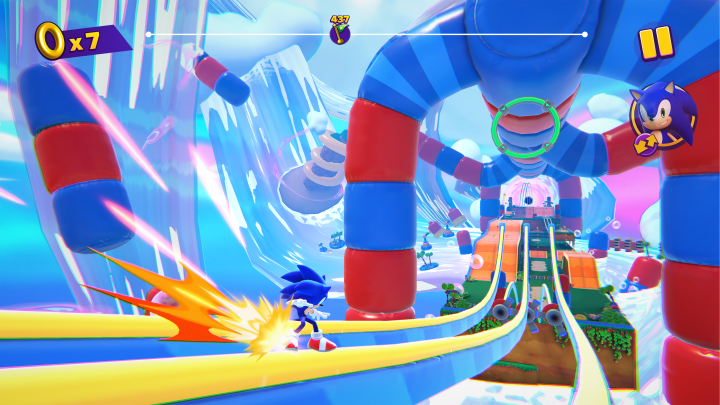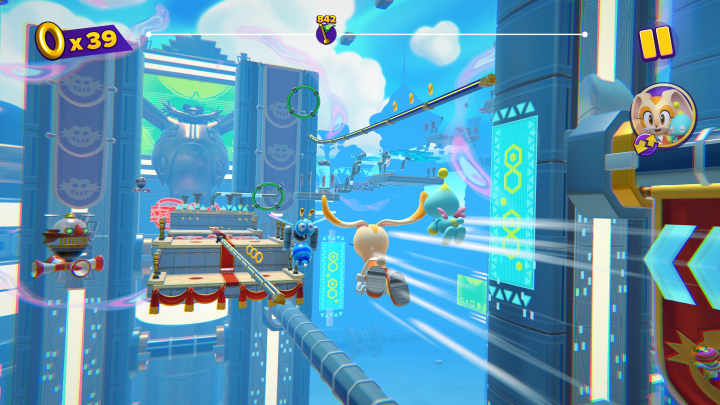“The fun, snappy Sonic Dream Team might just hold the blueprints for the hedgehog's future.”
- Great cartoon look
- Snappy movement
- Easy to learn controls
- Very replayable levels
- Finnicky camera
- Over just as it starts getting creative
- Recycled challenges
Sonic the Hedgehog games live and die on one word: momentum.
The series’ best games drop players in digital amusement parks full of interweaving attractions and let them freely jump from ride to ride without taking their foot off the gas. By contrast, its weakest entries litter those worlds with stop signs. The more players are forced to slow down, whether by design or unintended bugs, the less fun it is. “Gotta go fast” isn’t just a snappy catchphrase; it’s an imperative for the series.
Sonic Dream Team, a new Apple Arcade exclusive 3D platformer, understands the importance of momentum. That makes perfect sense when looking at its developer, Sega Hardlight. The studio is best known for Sonic Dash, a mobile endless runner that’s still moving 10 years after its launch. Uninterrupted motion is a necessity in that title and I can feel Sega Hardlight’s survival instinct at play in its latest game. It’s determined to make sure players never stop boosting, zipping between rails, and smashing through enemies to keep the ball rolling. That’s exactly the kind of thinking the start-and-stop Sonic series needs right now.
Though it ends just as it’s getting into its top gear, Sonic Dream Team is a wise direction for the ever-changing series. It’s not another radical reinvention nor a tired nostalgia act, but a sharply designed Sonic adventure that puts snappy 3D platforming at the forefront. If nothing else, it’s a successful audition for a developer who seems best equipped to take the series’ reins moving forward.
A platforming dream
In Sonic Dream Team, the villainous Doctor Eggman harnesses the power of dreams to construct his own evil empire. Sonic and Amy Rose team up with a new character named Ariem (pronounced REM … get it?) to foil his plan and save Sonic’s kidnapped pals in the process. It’s a simple enough story mostly told through motion comic cutscenes, but the small-scale presentation delivers more than some of its console counterparts. It includes full voice acting, some great tunes, and a pleasant cartoon art style – all of which make it stand out next to the recently released Sonic Superstars.
The real meat of the adventure comes in Sega Hardlight’s approach to fast-paced platforming, an area where the studio’s endless runner roots go to good use. Each of its 12 main stages (on top of four easy, but fun boss stages) are sleek and easy to navigate but call back to the level design of 3D classics like Sonic Heroes. They’re linear stages, but with several branching routes at each turn that hide collectible coins and stars. Some levels have me hopping between grind rails and homing into a line of enemies to reach an aerial path. More creative ones play with gravity; my favorite stage includes a section where I’m suddenly running up a cylindrical wall while jumping to avoid obstacles.
It’s the most consistent and reliable that movement has felt in a Sonic game in quite some time.
While none of that is unusual for the series, the key to Dream Team’s success is in its movement. Sonic and company can dash quickly between obstacles thanks to some simple and snappy controls that make sure players always land where they intend. When I jump towards a rail, I can press the homing attack button to automatically lock on to it and zip over. That’s also useful for bashing into enemies, bounce pads, and more. It’s the most consistent and reliable that movement has felt in a Sonic game in quite some time.
It’s clear that Sega Hardlight doesn’t want players to slow down and it knows how to support that idea. Each character has a boost meter which gives them a temporary burst of speed when pressed. Boost power can be regained by grabbing rows of energy (laid out in lines just like rings) and smashing enemies. When I’m really locked in, I can keep chaining together energy sources without ever taking my foot off the gas. Levels go by in just a few thrilling minutes as a result, making them the perfect length for quick on-the-go sessions.

As is the case with most modern Sonic games, there’s one extra gameplay gimmick, but it’s much more graceful than something like Sonic Superstars’ ability system. There are six playable characters in total: Sonic, Amy, Knuckles, Rouge, Tails, and Cream. They have three unique abilities between them, which can be used to reach alternate paths on each level. Sonic and Amy can light dash on rows of rings, while Tails and Cream can use their tails to fly upwards for a short time. The best of the bunch are Knuckles and Rouge, who can both climb up walls and glide in the air. Each character gives players a good reason to replay levels in order to hunt down hidden coins or find even faster routes to the finish line.
It isn’t without some imperfections. The 3D camera can be hard to tame, especially when dealing with Tails and Cream’s vertical gameplay. Some levels include short bits of careful platform hopping that slow down the pace a bit. And with a story that’s over in a quick four hours, it feels like I’m only getting an introduction to some of its more creative level design ideas. Even with those issues, Sega Hardlight proves that it isn’t a side studio that should be left on spin-off duty. It doesn’t overthink the simple pleasure of running fast, creating a series of mobile skateparks that are always satisfying to run through.
Reasons to come back
Though the main story is over in a flash, Sonic Dream Team finds other ways to keep players logging in. Between collectible statues unlocked through achievements and a whole bunch of hidden coins in every level, those who love a good platforming collect-a-thon will have a fair amount to dig back into after credits. The additional character powers help those replays stay fresh a few more times too as there’s always an extra handful of routes to discover.
The 12 levels start to feel stale after a while with all the revisiting …
Sega Hardlight tries to squeeze a lot of extra juice out of a small handful of levels with mixed results. The most inspired choice is a Super Mario 64-like structure, which gives each level a set of extra objectives. Completing one unlocks an orb and each new stage can only be unlocked by getting a certain amount. Those extra missions play to Dream Team’s strengths, as many task players with speedrunning through a level in a certain amount of time or racing through checkpoints to keep a timer going. It’s in those moments where I’m racing against the clock where I can feel just how tight the movement is, allowing me to barrel towards the end of a level without stopping.
Drawing on its mobile service roots, Dream Team also contains a mode called Tails’ Challenges, which gives players five bonus objectives every week. Each grants points that unlock new statues and players are scored in levels and placed on a leaderboard. It’s a nice extra for competitive players, though it seems as though the challenges mostly recycle ones from the base game. The 12 levels start to feel stale after a while with all the revisiting, but it sounds as though Sega Hardlight is prepared to keep updating the game for a bit. If it can gradually add new stages over time that widen the challenge pool, it could give the studio the longer tail it seeks.

Sonic fans may be tempted to skip Dream Team due to its Apple Arcade exclusivity and that’s understandable considering how light it is at present. Those who do have a subscription, though, will find a small blueprint for a successful 3D Sonic game. Fast movement, snappy controls, and an emphasis on fluidity over challenge make it one of the few modern installments that doesn’t come with some sigh-inducing gameplay caveat. For the first time since Sonic Mania, it feels like Sega has some actual momentum with Sonic Dream Team. I only open it keeps racing down this road instead of slamming the brakes and accelerating down yet another offramp.
Sonic Dream Team was tested on an iPhone with both touch controls and a Backbone controller.




